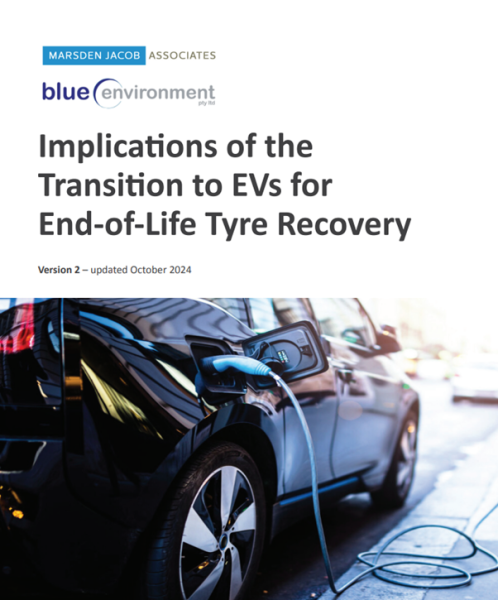Implications of the Transition to EVs for End-of-Life Tyre Recovery - Report
The aim of this report is to better understand the potential impact of the growing number of electric vehicle (EV) tyres on end-of-life tyre (EOLT) management, recycling processes, and the broader tyre industry.
The research was commissioned by Tyre Stewardship Australia in collaboration with two leading consultants, Marsden Jacobs Associates and Blue Environment.
The report details the findings from the research along with several key insights:
- EV Tyres on the Rise: By 2034, Australia will see up to 3.2 million EOLTs from EVs annually, representing a significant portion of the total tyre market.
- Advanced Tyre Technologies: EV tyres feature advanced designs like improved rolling resistance, noise reduction, stronger sidewalls, and additional performance layers. While the composition of tyres is being tuned for EVs, these ‘specific’ tyres are, and will likely remain, within the existing compositional spectrum for modern internal combustion engine vehicle (ICEV) tyres.
- Increased Processing Needs: Design features such as noise reduction foams and self-sealing layers can provide challenges to EOLT reprocessing, particularly with processing equipment sensitive to contaminants, such as equipment used when granulating or crumbing tyres. The current share of these tyres on the market is minor, and the impact was reported to be manageable by tyre processors currently. However, as EV-marketed tyres are more likely to contain these modifications, the increase in EV tyre numbers may accelerate additional processing needs.
- Tyre Wear and Emissions: Preliminary evidence indicates that for heavier vehicles, like EVs, the additional load and torque on tyres can lead to higher tyre wear rates on average. The long-term impact on non-exhaust emissions remains uncertain, but advancements in tyre technology, like stronger sidewalls, may help mitigate some of these challenges. Furthermore, the solutions for mitigating, capturing, and containing tyre wear microparticles will be the same for ICEV and EV-type tyres.
- Lack of specific standards: Currently, there are no standards in Australia for tyre design and tyre wear that is specific to EV tyres. Global regulatory trends like Euro 7 will likely influence future regulations for all tyres, include EV tyres, in Australia.
- Tyre design and future considerations: This research notes that changes in tyre design are already underway and are possibly being accelerated by the transition to EVs. The move to heavier and all-wheel drive vehicles, increasing recognition of the importance of circularity and the need to reduce the impacts of tyre wear are all factors influencing tyre design and composition. Whilst there is more work to be done, there is likely an opportunity to stay ahead of the curve in the management of EOLT through innovation and the development of more sustainable technologies and systems to suit emerging tyre materials.
Click here to download the full report.
